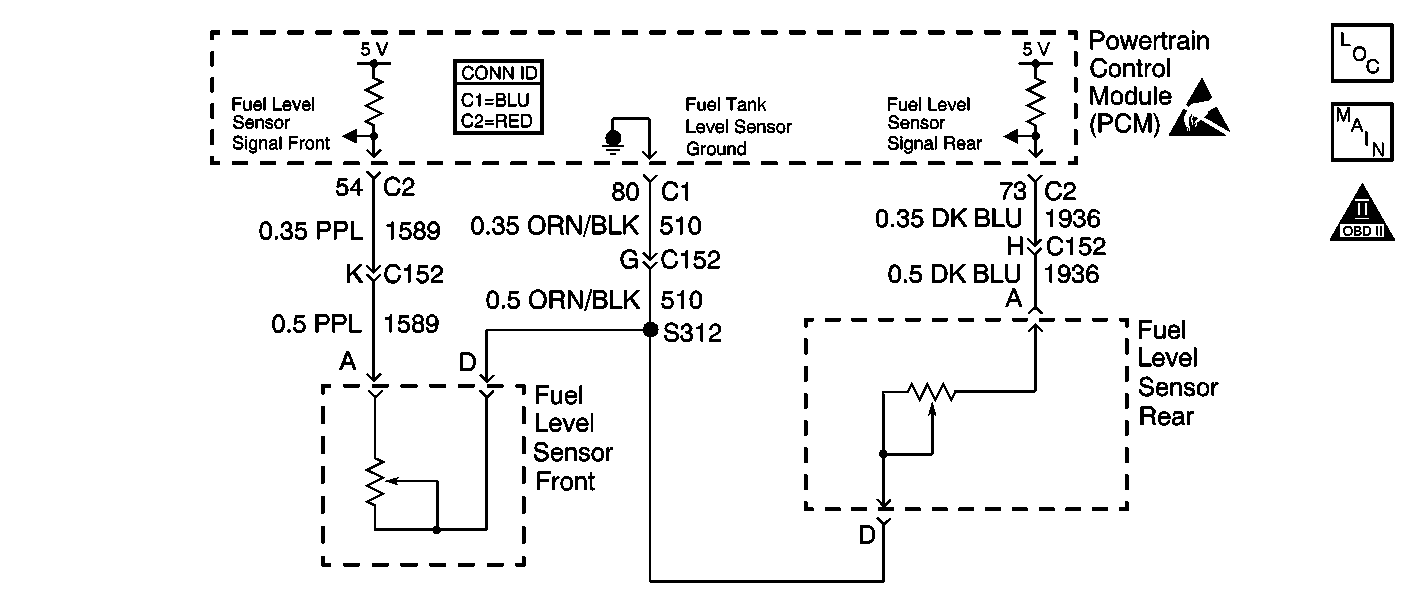
Circuit Description
The rear fuel level sensor, mounted in the rear side of the rear fuel tank, measures fuel level changes within the rear fuel tank. The fuel level sensor 2 has a signal circuit and a ground circuit.
When the fuel level is high the sensor signal voltage is high. When the fuel level is low the sensor signal voltage is low.
The PCM uses inputs from the fuel level sensor 1 and the fuel level sensor 2 in order to calculate the total fuel remaining in both fuel tanks. The system sends this information via the serial data to the IPC. This information displays on the fuel gauge.
This diagnostic tests for a stuck fuel level sensor 2 signal. If the PCM determines that the fuel level (rear tank) signal appears to be stuck based on a lack of signal variation expected during normal operation, this DTC sets.
Conditions for Running the DTC
The engine is operating.
Conditions for Setting the DTC
| • | The fuel level sensor voltage is below 0.39 volts. |
| • | The above conditions present for more than 2.0 minutes. |
Action Taken When the DTC Sets
| • | The PCM stores the DTC information into memory when the diagnostic runs and fails. |
| • | The malfunction indicator lamp (MIL) will not illuminate. |
| • | The PCM records the operating conditions at the time the diagnostic fails. The PCM stores this information in the Failure Records. |
| • | The vehicle fuel gauge displays empty. |
| • | The Check Gauge lamp illuminates. |
| • | The Driver Information Center displays a message. |
Conditions for Clearing the DTC
| • | A last test failed, or current DTC, clears when the diagnostic runs and does not fail. |
| • | A history DTC will clear after 40 consecutive warm-up cycles, if no failures are reported by this or any other non-emission related diagnostic. |
| • | Use a scan tool in order to clear the DTC. |
Diagnostic Aids
Important:
• Remove any debris from the PCM connector surfaces before servicing
the PCM. Inspect the PCM connector gaskets when diagnosing/replacing
the module. Ensure that the gaskets are installed correctly. The
gaskets prevent contaminate intrusion into the PCM. • For any test that requires probing the PCM or a component
harness connector, use the Connector Test Adapter Kit J 35616
. Using this kit prevents damage
to the harness/component terminals. Refer to
Using Connector Test Adapters
in Wiring Systems.
| • | Depending on the current fuel level, it may be difficult to locate a malfunctioning sending unit. The malfunction may only occur when the fuel level is full or near empty. The fuel sending unit may need to be removed for further diagnosis. A fuel level sensor that has an intermittent condition causes this DTC to set. Remove the fuel level sensor refer to Fuel Level Sensor Replacement in order to test the resistance of the sensor. The resistance of the sensor should change from 40 to 250 ohms. Replace the sensor if the resistance did not change or was out of range. |
| • | If the fuel level sensor is operating OK, test the operation of the Balance Pump. |
| • | The voltages in the Fuel Level Conversion Table are approximate values. Use this table to aid in diagnosis. |
Fuel Level Conversion Table | ||
|---|---|---|
Approximate Values | ||
Fuel Level | Front Tank voltage | Rear Tank Voltage |
100% | 2.5V | 2.5 |
75% | 2.5V | 1.5V |
50% | 2.5V | Less than 1.0V |
25% | 1.7V | Less than 1.0V |
0% | Less than 1.0V | Less than 1.0V |
For an intermittent condition, refer to Testing for Intermittent Conditions and Poor Connections .
Test Description
The numbers below refer to the step numbers on the Diagnostic Table.
Step | Action | Values | Yes | No |
|---|---|---|---|---|
1 | Did you perform the Powertrain On-Board Diagnostic (OBD) System Check ? | -- | ||
Is the Fuel Level sensor voltage below the specified value? | 0.39V | |||
3 |
Does the scan tool indicate that this diagnostic failed this ignition? | -- | Go to Diagnostic Aids | |
4 |
Does the test light illuminate? | -- | ||
5 | Using a J 39200 DMM, check the resistance between the rear fuel level sensor signal and the rear fuel level return circuits. Is the resistance below the specified value? | 35 ohms | ||
6 |
Does the DMM indicate continuity? | -- | ||
7 | Repair the short to ground in the rear fuel level sensor signal circuit. Refer to Wiring Repairs in Wiring Systems. Is the action complete? | -- | -- | |
8 | Replace the rear fuel level sensor. Refer to Fuel Level Sensor Replacement . | -- | -- | |
9 |
Important: Program the replacement PCM. Replace the PCM. Refer to Powertrain Control Module Replacement . Is the action complete? | -- | -- | |
10 |
Does the scan tool indicate that this test ran and passed? | -- | ||
11 | Select the Capture Info option and the Review Info option using the scan tool. Does the scan tool display any DTCs that you have not diagnosed? | -- | Go to the applicable DTC | System OK |
